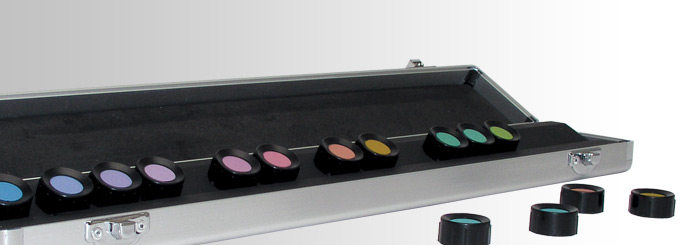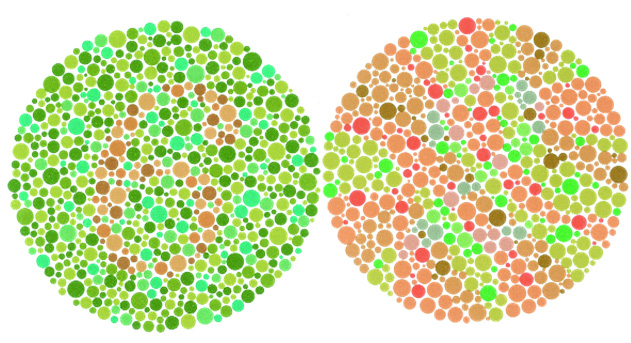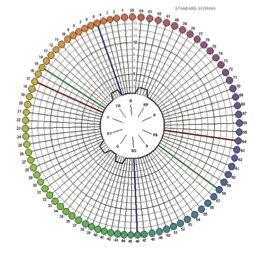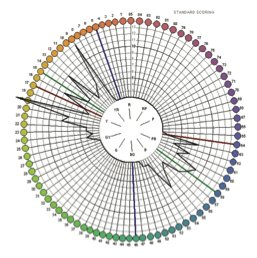In this series we’ve been discussing the many factors that impact how we see color, and what we can do to ensure the color we see is accurate.
Light, retinal fatigue and background effects can influence our perception of color. Today we’ll look at the limitations of the human eye and brain, and talk about how to detect these characteristics, especially for individuals responsible for evaluating and judging color.
Are YOU color deficient? Read on to find out. (Spoiler alert: There’s a test at the end. A color vision test!)
Color Deficiency
True color blindness, when a person sees only gray, is actually quite rare. Color deficiency is much more common. In fact, about one in every 13 men exhibits some type of color deficiency. For women, it’s much less, only about one in 300. (Explains a lot, doesn’t it, ladies?)
The culprit is a defective recessive gene on the X chromosome. Since females carry two X chromosomes, it’s quite rare that the defect is present on both. But males have only a single X, so if the defective gene is present, they are colorblind.
There are several common color deficiencies, but the most common is “red-green colorblindness.” Remember the color sensitive chemicals found in the human eye? When we stare at an object for longer than a few seconds, they are depleted from the cones and begin to send incorrect information to our unsuspecting brains. And there is something else that can go wrong with those color-sensitive chemicals.
Our eyes see only three color families: reds, greens, and blues. By adding these hues in varying amounts, we are able to see thousands and thousands of additional colors. If two of our chemical sensors (such as red and green) act the same, or if one of them is missing all together, the brain cannot mix RGB correctly to perceive accurate colors.
Even if your color-sensitive chemicals are all in check, there are many other physical limitations that can affect your ability to see accurate color.
Age
As we get older, our perception of color starts to fade. Carotene, a protein pigment, is responsible for this demise by invading the cornea and causing it to slowly turn yellow. You won’t notice it happening; but once it starts, it will continue.
Luckily color perception is not just inborn, it’s also a learned skill. People who are responsible for judging color differences get better with practice and can overcome the effects of age.
Poor color memory
Have you ever gone to the paint store and tried to choose a color from The Wall of Paint Swatches that will match your couch and curtains, from memory? How did that work for you? Human color memory is horrible! Even looking at two colors across the room from each other to see if they match is futile.
To compare colors, you need to look at them together, side by side, in a neutral environment… preferably under controlled lighting conditions.
Life
Stress, disease and medications all play a role in how our bodies function. Our eyes are not exempt from these life stressors. Even cultural, regional and ethnic influences can impact how we perceive color. Do your glasses have a UV coating? Are your contacts blue to help you find them when they fall on the bathroom floor? Although subtle, these tints can affect the way we see color.
The trick is to be aware of these life impacts so you can adjust.
Are YOU color deficient?
What do you see? A circle of colorful dots? Anything else? If you don’t see a “6” in the left circle and a “2” in the right, you probably suffer from some type of color deficiency. Luckily there’s an easy way to know for sure.
There are a number of tests to determine if an individual has normal color vision. One among them, the Farnsworth-Munsell 100 (FM 100) Hue Test, is available from X-Rite. It’s simple. You just arrange a series of color pucks into hue order. OK, maybe the process is simple, but the test itself can make you feel a little overwhelmed. The differences in shade are so subtle that you really need to have superior color vision to get them correct.
Here’s what FM 100 scoring looks like:
The person on the left has very good color discrimination, but not perfect. Those four small bumps show errors in the hue order of the chips. A perfect score would have a completely smooth circle at the center.
The person on the right lacks the color-sensitive chemical needed to recognize green shades. This graph shows the most common form of color deficiency, called duteranopia.
What to do? Test yourself!
If your color vision has fiscal ramifications, you really should take the physical test… which you can do as part of our Fundamentals of Color and Appearance seminar.
If you’re just curious, the online FM100 hue test will at least give you an idea of your color vision prowess.
So… how did you do? Let us know!
Color Perception Blog Series |
|---|
| Part 1: The Effect of Light |
| Part 2: The Impact on Manufacturing |
| Part 3: The Tricks the Environment Plays on Our Eyes |
| Part 4: Human Traits |




